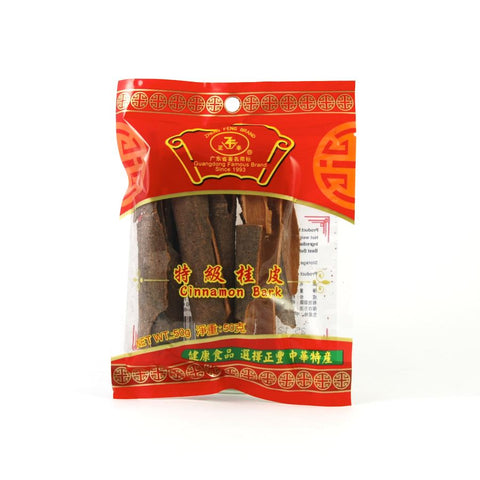What is Cassia Bark?
by Holly Thomson

Cassia bark, often confused with cinnamon, is a robust aromatic bark that closely resembles cinnamon in flavour but is distinguished by its thicker and coarser texture.
Originating from the cassia tree of South-East Asia, a member of the laurel family, cassia is a staple in many Chinese and Indian dishes, especially those that involve red braising.
Its warm, bittersweet flavor profile is best released through slow cooking methods.
Often referred to as 'Chinese cinnamon' or simply cinnamon 'bark', as labeled on many packets, cassia stands apart from 'true' cinnamon.
True cinnamon features much finer quills that are more readily ground into a fine powder.
In contrast, cassia bark is ideally suited for recipes requiring long cooking times, such as braising, where the whole bark can be submerged to slowly infuse the dish with its distinctive taste.
Browse all herbs and spices here or use your cassia bark in this recipe for Vietnamese pho.
Introduction to Aromatic Bark: Cassia
What is Cassia Bark?
Cassia bark comes from the evergreen tree Cinnamomum cassia, native to China and widely cultivated in Southeast Asia.
Unlike its cousin, true cinnamon (Ceylon cinnamon), cassia bark is thicker, coarser, and darker in colour.
It has a stronger, more pungent flavour, making it a popular choice in dishes that require a bold spice profile.
The bark is harvested by peeling it from the tree, then drying it, causing it to curl into thin strips or quills known as bark curls.
Though often used interchangeably with cinnamon, cassia bark has unique characteristics that set it apart, both in taste and appearance.
Understanding these differences is crucial for any culinary enthusiast looking to master the use of spices in their cooking.
Historical Uses of Cassia
Cassia bark has a history in the kitchen that dates back thousands of years.
In ancient China, it was highly valued for both its medicinal properties and its role in recipes. Cassia was also a treasured commodity along the Silk Road, traded extensively between Asia, the Middle East, and Europe.
The Egyptians used it as part of their embalming process, while the Romans appreciated it as a spice. In medieval Europe, it was considered a luxury, often reserved for the wealthy.
These diverse uses across cultures and eras underscore cassia bark’s importance beyond just flavouring food. Its robust aroma and therapeutic qualities have made it a staple in traditional medicine, cooking, and even religious rituals.
Cassia vs. Cinnamon: Key Differences
Cassia and cinnamon are often confused, but they have distinct differences.
- True cinnamon, known as Ceylon cinnamon, is lighter in colour and has a delicate, sweet flavour.
- In contrast, cassia bark is darker, thicker, and has a more robust, spicy taste.
- The texture of cassia, which still has the rough outer bark attached, is coarser, making it harder to grind compared to the softer, more crumbly texture of Ceylon cinnamon.
- Additionally, cassia contains higher levels of coumarin, a natural compound that can be harmful in large quantities, whereas Ceylon cinnamon has much lower levels.
How to Use Cassia Bark
Traditional Recipes with Cassia
Cassia bark is used in a variety of traditional recipes. Cassia buds, with their mild, flowery cinnamon flavour, are used in pickles, curries, and other traditional recipes such as old-fashioned pickling, marinades, and teas.
In Chinese cuisine, it is a key ingredient in the famous five-spice powder, which is used to season meats and enhance broths. In Indian cooking, cassia bark is often included in garam masala blends and biryanis, adding depth and warmth to the dishes.
Middle Eastern cuisines also embrace cassia bark, particularly in rich stews and tagines, where its strong flavour complements other spices. Additionally, cassia bark is used in various sweet treats, such as spiced cakes and desserts, where its robust taste pairs well with sugar and other sweet ingredients.
These traditional recipes showcase cassia bark’s ability to enhance a wide range of dishes, making it a staple in many kitchens around the world.
In modern cuisine, cassia bark continues to be a popular spice, finding its way into both traditional and innovative dishes. Chefs and home cooks alike appreciate its strong, warm flavour, which can enhance both sweet and savoury recipes.
Cassia is often used in contemporary baking, adding a distinctive spice and sweet flavor to biscuits, cakes, and pastries. It is also a favourite in craft beverages, such as spiced teas, mulled wines, and flavoured coffees.
Beyond baking, cassia bark is employed in modern savoury dishes, from spiced rubs for meats to aromatic soups and sauces. Its versatility extends to fusion cuisine, where it pairs well with a variety of spices from different culinary traditions.
This adaptability makes cassia bark a valuable ingredient for those looking to add a bit of spice and complexity to their culinary creations.
3 Recipes using Cassia Bark
Tips for Cooking with Cassia
First, remember that a little goes a long way; its strong taste can easily overpower other ingredients, so use it sparingly.
When adding cassia to soups, stews, or braises, consider using whole sticks and removing them before serving to impart flavour without leaving gritty bits.
Ground cassia can be used in baking and spice rubs, but ensure it's finely ground to blend well.
Store cassia bark in a cool, dry place to maintain its potency, and grind it fresh for the best flavour. Finally, balance cassia with complementary spices like cloves, star anise, and cardamom to create complex, well-rounded dishes.
These tips will help you harness the full potential of cassia bark in your cooking.
Browse all herbs and spices here or use your cassia bark in this recipe for Vietnamese pho.




